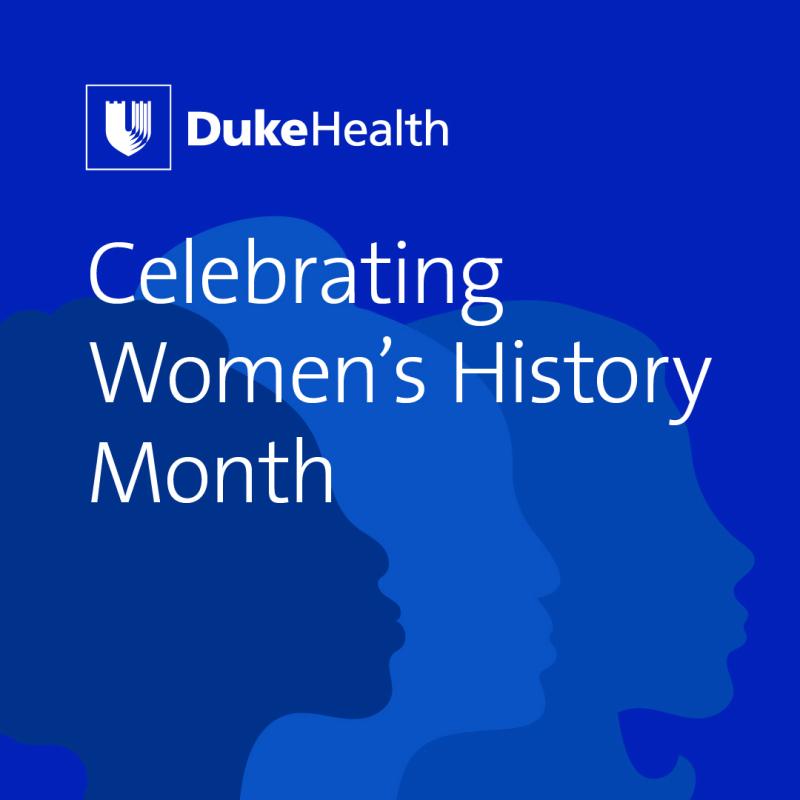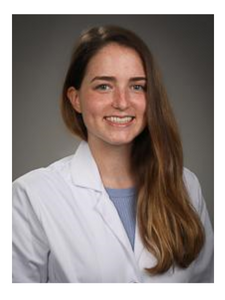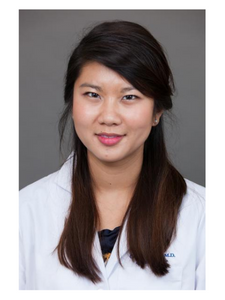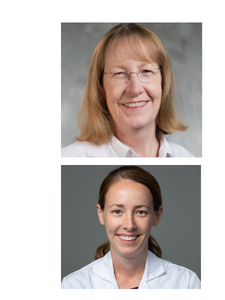
Women's History Month is a time for learning about the past and looking to the future. These essays reflect a sub-theme of the challenges women in medicine still face today - and what they are grateful for in their professional journeys. While we celebrate the women of medicine in March, listening to their voices helps us all better understand ourselves and how we can all make a difference in the struggle for equality.
Underneath My Smile

By Amanda Broderick, MD
2024-2025 Chief Resident, Duke Regional Hospital/Ambulatory Medicine
People often mention that I smile a lot. I don’t mind hearing this; I think a smile can quickly set the approachable and kind tone that I view as foundational to my role as a physician. Usually, my smile is genuine – because I love my job, my colleagues, and caring for patients. However, as I’ve progressed in my medical training, I’ve noticed that sometimes my smile isn’t so sincere; sometimes it’s more of a gritting of my teeth to hide my discomfort.
Women in medicine are familiar with the micro- and, at times, macro-aggressions that occur daily in hospitals and clinics. We’re showered with inappropriate comments on our appearances; probing questions about our reproductive plans or other aspects of our personal lives; being called “sweetie” or “honey” more often than we are called by the role or name we just introduced ourselves with; or the insistence that the doctor has not been in to see the patient yet (because only women have seen them so far).
During medical school and much of my intern year, my inclination in these situations was to silently smile despite my discomfort. I think that for many women, especially those of us early in our careers, this is not an uncommon reaction. It is easier to speak up when comments are directed at others. However, when they’re directed at us, we want to spare everyone in the room the discomfort and embarrassment that we feel and not draw attention to the situation in case others might think we are “overreacting”. We pretend like we didn’t hear that inappropriate comment or see that inappropriate gesture; we quietly smile or uncomfortably laugh. These situations are not only exhausting but are also dismissive of our abilities as medical providers and our expertise gained over years of education and training.
It should not be just our responsibility as women to undo the biases that still exist in a historically male-dominated medical field. It is important that men also stand up to directly challenge patients and other providers – as we all should for our colleagues who face any type of bias - to start a productive dialogue. Here at Duke, I am grateful for the many students, residents, attendings, and leaders that model change and start these conversations. They have given me the confidence to remember that I do not have to hide my discomfort– and that I only need to smile when genuine.
Untitled

By Cecelia Zhang, MD
Assistant Professor, Gastroenterology
I was a fellow mid-training when one of my preceptors mentioned that we should add a clinic patient to multidisciplinary conference for discussion. “I’ll send a message to Erin”, she commented as we wrapped up. The following month, I took one of my junior co-fellows to conference and introduced him to “Erin” casually mentioning that he should message her if he has anyone to add. Without skipping a beat, Erin kindly said “Yes, I add people to the list. I also read all the imaging for conference in addition to being the division chief.” I was mortified.
Several years later, I think about how important introductions are to providing context. When I was a new faculty member visiting my practice sites, I was introduced to most of the staff by my nickname “Cece”. No full name. No title. This ultimately created an uneasy dynamic as then I was further introduced by the endoscopy or clinic team to patients by my nickname or called my first name in the procedural setting. It is not infrequent for patients to comment “you look too young to be a doctor”, “how many times have you done this?”. Women often must overcome inherent negative assumptions about their capabilities.
These inequities have been likened to gnat bites. Irksome as one, but painful as they build up. During COVID, one of my female colleagues noticed that her PPE bag was the only one with her nickname on it while the rest of the faculty had their last name. Another lamented that our staff kept referring to her by her first name while in the same sentence called her male co-fellow Dr. Another called attention to an agenda where the credentials of a female provider were left off despite being written for every other presenter. While seemingly small acts of inattention – these daily, weekly, monthly microaggressions are additive and can have ripple effects. Many times, it feels that asking to be treated the same means that we are asking for more.
Our former pediatrician is a colleague and friend of mine, but I have always referred to her by her title “Dr. Lee” to my kids. In this setting, I am nurturing them to value her professional expertise. Our new pediatrician asks her patients to address her by her first name. We also must respect that some physicians have a different preference for their practice. Ultimately, women should feel empowered to have a choice rather than others making it for them.
For some, the title may not be important as there are natural privileges in being what people expect a gastroenterologist should look like. For others, the title “doctor” is powerful and not because of ego. It is an anchor word that can sever implicit bias, mitigate imposter syndrome, and give a sense of belonging.
Role Models Matter

By Anita Kelsey, MD, MBA, Professor, Cardiology and Michelle Kelsey, MD, Assistant Professor, Cardiology
Women in medicine, and women in cardiology, face many challenges – balancing personal and professional responsibilities, navigating a landscape which is male-dominated, and often receiving unequal compensation for their efforts. One of the most important resources for trainees entering this field are visible female role models – to serve as motivation, inspiration, and support.
When Anita Kelsey started cardiology fellowship at Duke in 1995, four out of eight fellows in her class were women. Despite the small numbers of women in cardiology overall, her class was balanced, 50/50. When Anita graduated cardiology fellowship in 1998 and moved to Connecticut for her first attending job, Duke had more women on faculty in Cardiology than the entire state on Connecticut. Although women still made up only a small proportion of the division at Duke, these female physicians were strong, and most importantly visible, role models for younger trainees.
When Michelle Kelsey started cardiology fellowship in 2018, 23-years after her mom, Anita, four out of the eight fellows in her class were women. And although women still make up only a small proportion of the field of cardiology (less than a quarter of practicing cardiologists nationally), Duke remains committed to training young women in this discipline and continues to provide a cadre of strong female role models.
Anita joined the faculty at Duke in 2019, and Michelle in 2022. Among only a few mother/daughter pairs in Cardiology (and the only, to our knowledge, to train at the same institution), we are passionate about supporting women in medicine and grateful for the role models we have had along the way.
We Continue to Encounter Significant Struggles

By Julie Steinbrink, MD, MHS
Assistant Professor, Infectious Diseases
While women in medicine today are fortunate in many ways compared to previous generations, we continue to encounter significant struggles. One obstruction that persists to varying degrees is a decreased level of overall respect given to women physicians compared to men. Published studies (and personal experience) demonstrate that women are less likely than men to be addressed by their title as doctor – instead addressed by their first name, both by patients as well as when introduced at medical conferences by colleagues. Many women physicians can also relate to the experience of entering a clinical room and being mistaken for an ancillary provider. These may sound like small slights, but when encountered frequently enough over a prolonged period, these events contribute to overall career discontentment, imposter syndrome, and physician burnout.
Furthermore, as a new mother, I have become acutely aware of the challenges of balancing a family with a career in medicine and how this disproportionately impacts women. This starts with the ubiquitous question of when the ‘optimal’ time for childbearing is in one’s medical career (spoiler alert, there isn’t one). Later, even in two-career households, women often cover most dependent care/household responsibilities and are perceived to be the primary caregiver. Personally, though my spouse is listed as the ‘first call’ at my child’s daycare due to his more flexible (non-medicine) work schedule, I am still (as the mom) always the first parent they contact with an issue or question.
Furthermore, a potent concern for me and many women in academic medicine is the stress of keeping up with research productivity and ongoing caregiving needs (whether they be childcare, eldercare, or other). Many women may be required to make up clinical work after returning from parental leave, diminishing their ability to focus on research or other scholarly pursuits. This added pressure is combined with additional published gender disparities in research, including discrepancies in authorship and funding acquisition. An inability to pursue scholarly work incites further tension regarding the downstream impact this has on promotion timelines and career advancement.
The balance of caregiving needs with the tenure clock is particularly anxiety-inducing to junior faculty who are only starting to climb the academic ladder. It can feel disheartening for such faculty to not see women in senior and leadership roles, as ‘you can’t be what you can’t see.’ Though women now make up half or more of medical school classes, and the number of women at all faculty ranks has increased over time, we remain disproportionately under-represented at higher career ranks or as division/departmental heads.
These examples, among others, are only a sampling of some of the challenges women in medicine encounter today, and some of the many reasons why ongoing work is necessary to achieve further gender parity in medicine.